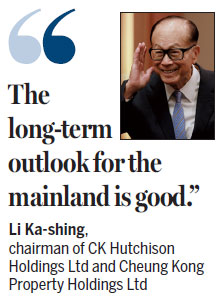
For a Chinese supercomputer to top the list of the world's fastest is nothing new; one has held the spot for seven years straight now.
But this time around marks a couple of firsts. For the first time, the winning machine uses only Chinese-designed processors.
It's also head-spinningly fast at 124.5 petaflops (quadrillion) operations per second. Nothing the US has even comes close.

China also nudged aside the US (for the first time) as the country with the most supercomputers in the top 500 - China 167, US 165. (Japan is a distant third with 29).
The No 1 system, called Sunway TaihuLight, is maintained at the National Supercomputing Center in Wuxi, west of Shanghai, according to TOP500, the organization that runs the biannual computer showdown.
It's used for advanced manufacturing like airplane design, Earth-system modeling and weather forecasting, life science and analyzing big data.
Running such "sizeable applications", said Jack Dongarra, a professor of computer science at the University of Tennessee and one of the editors of the Top500 list, "shows that the system is capable of running real applications and is not just a stunt machine."
"Considering that just 10 years ago, China claimed a mere 28 systems on the list, with none ranked in the top 30, the nation has come further and faster than any other country in the history of supercomputing," the TOP500 organizers said in a statement.
By way of contrast, TaihuLight's top speed is about five times that of Oak Ridge's No 3-ranked Titan and uses almost twice as much electricity.
"As the first No 1 system of China that is completely based on homegrown processors, the Sunway TaihuLight system demonstrates the significant progress that China has made in the domain of designing and manufacturing large-scale computation systems," Professor Guangwen Yang, the Wuxi center's director was quoted as saying in the TOP500 press release.
The TaihuLight uses Chinese-developed ShenWei processors, "ending any remaining speculation that China would have to rely on Western technology to compete effectively in the upper echelons of supercomputing," the TOP500 said.
According to Dongarra, the TaihuLight is 2.75 times as fast as the former No 1, the Guangzhou-based Tianhe-2, which uses chips made by Intel.
"Tianhe-2A was supposed to be upgraded with Intel's Knights Landing (their fastest) processors," Dongarra wrote online, "but last year the US Department of Commerce blocked the export of Intel technology to some parts of China." 
In response, "China invested heavily in HPC (high performance computing) research and development and they are replacing Intel with their own designs," he said.
It's now a matter of debate whether the ban spurred the Chinese to develop their high-performance computer technology faster, but the trend worldwide is to reduce dependence on US technology.
"The Chinese were already determined over time to move to an indigenous processor," computer analyst Steve Conway told Computer World. The ban, he added, "increases that determination."
Supercomputing has become increasingly important in the economy, national security and high-end manufacturing and design and fraud detection. It is now "so strategic that you really don't want to rely on foreign sources for it," Conway said.
In July 2015, just four months after the Intel ban, President Obama issued an executive order instructing government agencies to work together to break into the next level of speed above the petaflop - the exascale (or quintillion), delivering "a capable exascale computing system that integrates hardware and software capability to deliver approximately 100 times the performance of current 10 petaflop systems."
Obama gave them 15 years to get it done. They aim is to have it done earlier, by 2023.
Last week, China announced that it plans to break the exascale ceiling by 2020.
The race is (still) on.
Contact the writer at chrisdavis@chinadailyusa.com
(China Daily USA 06/22/2016 page2)
Hillary Clinton likes to take the credit, but never the blame